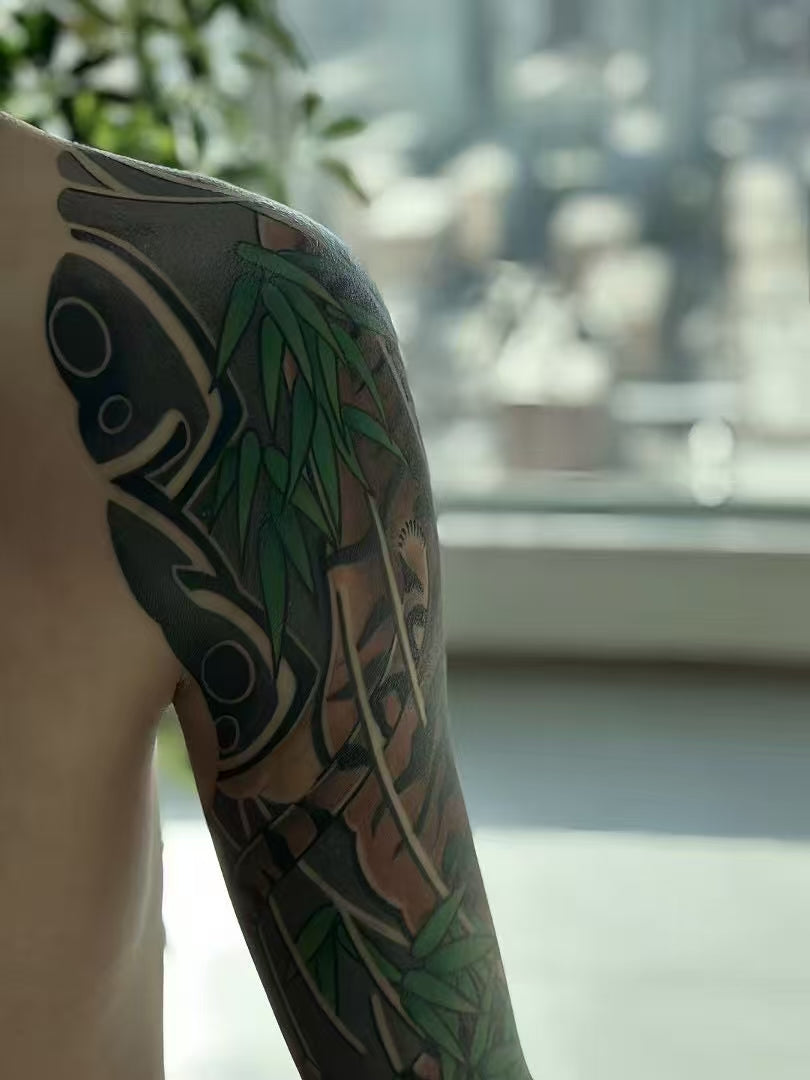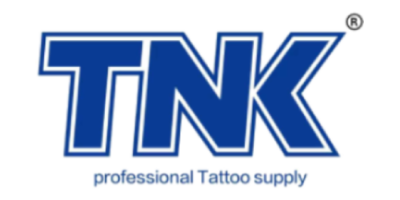
Tattoo Needles Guide: Rotary vs Traditional Machines
Share
• Diameter (Gauge): This is the thickness of each individual needle pin in the grouping. It's a key factor in how much ink the needle can carry and put down. The most common diameters are #12 (Standard), #10 (Bugpin), and #08 (Bugpin). The specific measurements are:
○ #12 Gauge = 0.35mm
○ #10 Gauge = 0.30mm
○ #08 Gauge = 0.25mm
A larger diameter like a #12 allows for greater ink flow, perfect for bold lines and packing. A smaller diameter, often called a bugpin, limits ink flow for finer detail and smoother shading. For a complete breakdown, it's worth a deep dive into understanding tattoo needle diameters.
• Taper: Taper refers to the length of the point at the very end of each needle. A short taper has a thick point and puts down more ink, making it great for bold lining. A long or extra-long taper has a much finer point, which causes less damage and is perfect for detailed work and soft shading, as it puts down less ink per puncture.
• Count: The count is simply the number of individual needles joined together in a single grouping. For example, a 7RL is a grouping of seven needles arranged in a round liner setup.
The Core Setups
Needles are grouped into specific shapes, or setups, each designed for a particular job in the tattooing process.
• Round Liners (RL): These needles are grouped into a tight, round formation. Their only purpose is to create clean, sharp outlines. The tight grouping ensures a solid, steady line.
• Round Shaders (RS): Similar to liners, but the needles are spaced slightly farther apart. This allows them to hold more ink and create softer lines, making them good for small areas of shading, color fill, or creating thicker lines.
• Magnums (M1, M2, CM/RM): Magnums are the workhorses for shading and coloring large areas efficiently. They consist of two rows of needles.
○ A Weaved Magnum (M1) has the two rows spaced apart.
○ A Stacked Magnum (M2) has the two rows packed tightly together.
○ A Curved Magnum (CM or RM) has an arched shape to the needles, which helps spread ink more evenly and causes less damage to the edges of a shaded area.
• Flats (F): These feature a single row of needles joined in a straight line. They are excellent for creating precise geometric shapes and unique blending effects.
Matching Machine to Mission
This is where theory becomes practice. Combining the right machine with the right tattoo needles for a specific artistic goal is what separates a technician from an artist. Let's explore some practical, real-world scenarios.
Scenario 1: Delicate Fine-Line Botanicals
• The Goal: To create sharp, single-pass lines with the utmost precision and minimal potential for blowouts, often on sensitive skin areas like the inner arm or ribs.
• Recommended Setup: A direct-drive rotary machine, like a pen-style model, set to a lower voltage. Pair this with a 3RL or 5RL bugpin (#10 gauge) long-taper needle cartridge.
• The Rationale: This is a game of finesse, not force. The rotary's gentle and steady motion is perfect for this task. It glides the needle into the skin without the aggressive punch of a coil, greatly reducing the risk of overworking the skin and causing a blowout. The bugpin's smaller diameter and the long taper of the needle create the finest possible point of contact, allowing for precise ink deposit with minimal damage. This setup is all about control and delicacy.
Scenario 2: Bold American Traditional Color
• The Goal: To pack solid, vibrant color into a large area, achieving full saturation efficiently and with a single pass if possible.
• Recommended Setup: A powerful coil machine tuned for packing. Use a 9 or 13 Weaved Magnum (M1) with standard gauge (#12) needles, typically on a traditional needle bar.
• The Rationale: This task requires raw power. A large M1 needle grouping needs significant force to penetrate the skin effectively and deposit a large amount of ink. The characteristic "punch" of a coil machine is built for this. It drives the needles in with enough authority to ensure the ink is packed solidly into the dermis. The standard #12 gauge needles allow for maximum ink flow, and the weaved magnum setup covers a lot of ground quickly, making it the most efficient choice for this style.
Scenario 3: Buttery Smooth Black and Grey Realism
• The Goal: To build up soft, seamless gradients and subtle textures for a realistic portrait or image, requiring multiple passes and layering.
• Recommended Setup: A variable-stroke rotary machine paired with a large (e.g., 15) Curved Magnum (CM) bugpin (#10 gauge) needle cartridge.
• The Rationale: Realism is built in layers. The smooth, non-traumatic action of a rotary is essential here because you will be working over the same area multiple times. A coil machine would likely overwork the skin and create a muddy result. A curved magnum is the star player; its arched shape allows you to feather the edges of your shading effortlessly, preventing hard lines and creating seamless blends. Using bugpin needles provides a finer "pixelation" or dot pattern, which translates to a smoother, more photo-realistic gradient when healed. The ability to adjust the stroke on the machine gives you further control over how softly or firmly the ink is applied, a key detail explored in insights from professional artists on machine stroke.
The Artist's Touch
Technical knowledge is the foundation, but artistry lies in the translation of feel. Learning to interpret the feedback from your machine is a skill developed over thousands of hours. It's the physical conversation between you, your machine, your needles, and the client's skin.
The Give vs. The Chatter
The feedback from a rotary and a coil are worlds apart. A high-quality rotary machine has a smooth, almost silent "give." It glides with minimal vibration. This means the artist must rely more on visual cues - watching the skin for the right amount of stretch and ink deposit - and a deep, natural understanding of their voltage and stroke settings.
A coil machine, on the other hand, "chatters." It provides a constant stream of vibration and sound. An experienced artist learns to read this feedback. They can feel the difference in skin resistance between the forearm and the stomach. They can hear a change in the machine's hum that indicates it's getting bogged down or running too fast. This feedback loop allows for on-the-fly adjustments that are purely instinctual.
Adjusting Your Technique
This difference in machine feedback directly impacts your physical technique, primarily hand speed and pressure.
There's a golden rule: with a fast-running rotary, your hand must also move quickly. Its efficiency means it's implanting a lot of dots in a short amount of time. A slow hand speed with a fast rotary will overwork the skin, leading to excessive damage and poor healing.
On the other hand, a hard-hitting coil machine used for packing color often requires a slower, more methodical hand speed. This allows the machine's power to do the work, giving the large needle grouping enough time in the skin to deposit its ink payload fully. Rushing this process with a coil can result in patchy, undersaturated color. The ultimate goal is to find the perfect harmony between the machine's speed, your hand's speed, and the specific job your chosen tattoo needles are designed to do.
The Modern Standard
Beyond artistry and technique lies a non-negotiable foundation: safety and hygiene. Modern equipment has made our work safer and more efficient than ever, and following these standards is a core responsibility of every professional artist.
The Cartridge Revolution
Tattoo needle cartridges, now the standard for most rotary machines, have been a game-changer. These all-in-one units contain the needle grouping within a disposable plastic housing, which simply clicks or twists into the machine. This streamlines the setup and teardown process immensely.
However, their most critical innovation is the safety membrane. This is a flexible barrier inside the cartridge that prevents ink, blood, and other fluids from flowing backward into the machine grip and the machine itself. This is a crucial feature that prevents cross-contamination between clients and protects the investment you've made in your equipment. Always use cartridges with a reliable, well-engineered membrane.
Non-Negotiable Safety Protocols
Whether using cartridges or traditional needles on a bar, some safety rules are absolute. Following these protocols protects your clients, your reputation, and your career.
• Every needle or cartridge must be sterile, individually packaged, and from a reputable supplier.
• The package must be opened in front of the client immediately before the tattoo begins.
• Needles are strictly single-use. They must never be reused on another client or on the same client in a different session.
• After use, all needles must be disposed of immediately and correctly in a designated, puncture-proof sharps container, according to local health regulations.
Frequently Asked Questions
Q: Can I use the same needle setup for both rotary and coil machines?
A: While you can technically use the same needle configurations, the results will vary significantly. Rotary machines work better with bugpin needles for smooth shading, while coil machines excel with standard gauge needles for bold lines and solid color packing. The machine type should influence your needle choice for optimal results.
Q: What's the difference between bugpin and standard needles?
A: Bugpin needles (#10 or #08 gauge) are thinner than standard needles (#12 gauge). They carry less ink per puncture, making them ideal for fine detail work, smooth gradients, and realistic shading. Standard needles carry more ink and are better for bold lines and solid color fills.
Q: How do I know if my needle cartridge has a safety membrane?
A: Quality needle cartridges will clearly state they include a safety membrane on the packaging. You can also visually inspect the cartridge - look for a flexible barrier visible inside the plastic housing. Never use cartridges without this safety feature as they can cause cross-contamination.
Q: Why does my rotary machine work better at higher speeds for shading?
A: Rotary machines at higher speeds create smoother gradients because they deposit more dots per inch of movement. However, this requires faster hand movement to prevent overworking the skin. The key is finding the right balance between machine speed and hand speed for your specific technique.
Q: Can I switch between different needle configurations during the same tattoo session?
A: Yes, switching needle configurations during a session is common practice. You might use round liners for outlines, then switch to curved magnums for shading. Always use fresh, sterile needles for each configuration change and dispose of used needles immediately in a sharps container.
